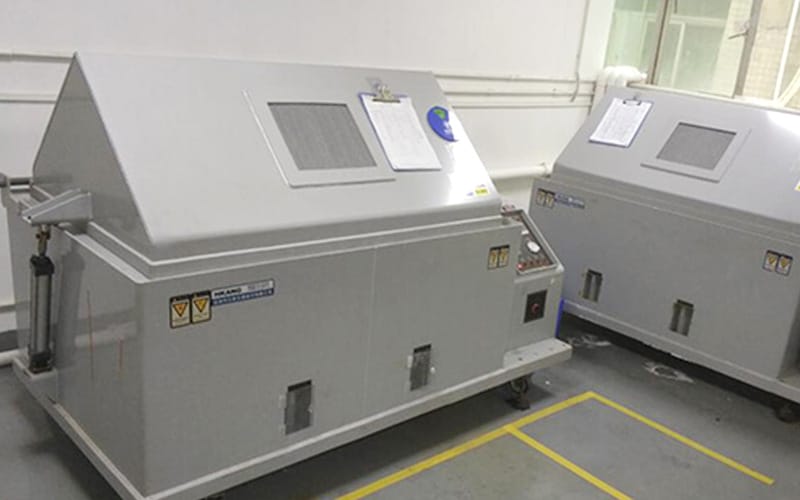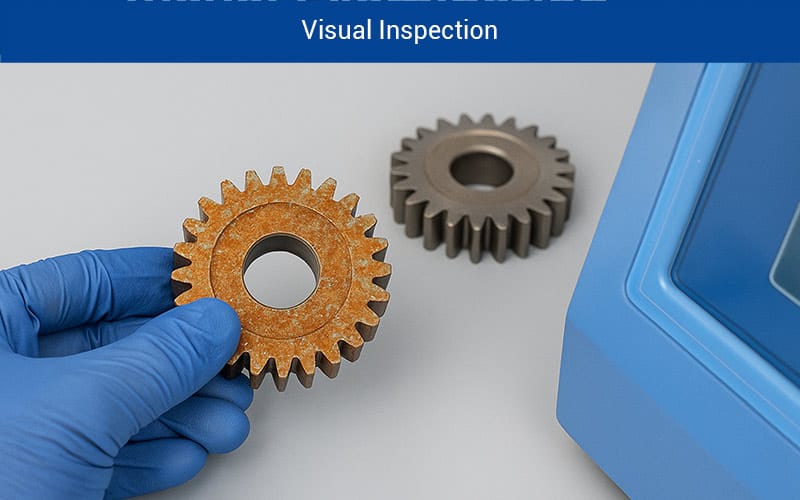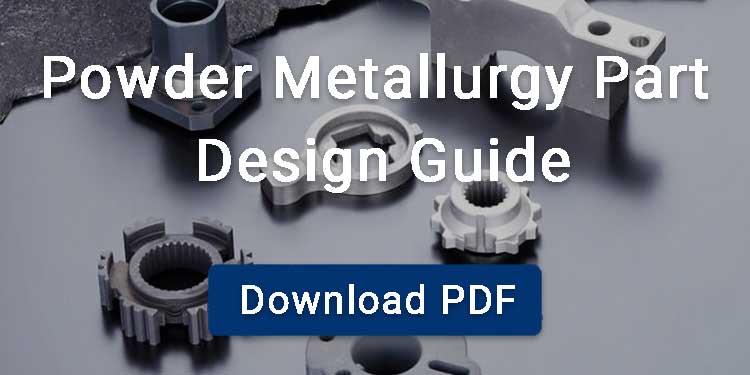Salt spray test, also known as the salt fog test, is a standardized method used to simulate and accelerate the effects of a corrosive environment to evaluate the corrosion resistance of materials, coatings, or surface treatments.
This test is performed to check whether the component can withstand harsh conditions like in seawater or when exposed to a high oxidative or reductive environment. It is used by various industries, such as aerospace and automotive, to check the reliability and durability of sensitive components under harsh conditions.

Contents
Purpose of Corrosion Test
Corrosion testing plays a vital role in the engineering and manufacturing industries because it enables the manufacturers to know whether their product can withstand the real world conditions or not. Corrosion test also evaluates the effectiveness of various surface finishing processes such as galvanizing, painting, anodizing, or powder coating. Additionally, it ensures that products meet relevant industrial standards.
Principle of the Salt Spray Test
Salt spray corrosion test works on the principle of the provoking occasion by simulating harsh marine like conditions in a controlled chamber. In this test, 5% sodium chloride (NaCl) solution is atomized using compressed air and sprayed on the component from 24 to 1000 hours, depending upon the requirements. The continuous supply of mist of NaCl contributes to electrochemical corrosion, and the corrosion resistance of the component is determined. Different test standards, such as ASTM B117 and ISO 9227, specify the test procedure, duration, and evaluation criteria.
Salt Spray Test Procedure
This procedure is based on astm b117 salt spray test standards.
Sample Preparation
First of all, the sample whose salt spray testing is to be done is cleaned from any oil, dirt or debris. After thorough cleaning, it is placed inside the testing chamber in such a way that the whole area is exposed.
Solution Preparation
5% sodium chloride (NaCl) solution is prepared. Here a solution of NaCl using 99% pure NaCl and distilled or deionized water is prepared and filtered to remove any insoluble particle that can be stuck into the nozzle of the atomizer. The pH of the solution is maintained between 6.5 to 7.2.
Usually, three types of salt spray solutions are used:
Neutral Salt Spray Test (NSS): The most widely used,Suitable for Metals and their alloys, metal coatings, anodic oxide coatings, organic coatings.
AASS solution: Acetic Salt Spray, glacial acetic acid is added to the neutral saline solution. This solution is suitable for decorative coatings of copper-nickel-chromium,nickel-chromium as well as for anodic and organic coatings on aluminium.
CASS solution:Copper chloride dihydrate (CuCl2 2H2O) is added to the neutral saline solution.It is specifically designed for accelerated corrosion testing of decorative coatings such as copper–nickel–chromium, nickel–chromium, anodized aluminum, and organic coatings on aluminum.
Salt spray test Chamber preparation
In this step, the solution is placed in the chamber reservoir, and the temperature of the chamber is set e to 35°C (95 °F). To complete the setup, the continuous automatization of the sample is assured by using compressed air.
Test Execution
Finally, the astm salt spray test is started, and salt mist is allowed to settle on the specimen at a rate of Starting the
1.0 – 2.0 mL/hour per 80 cm² of horizontal collecting area. Her typical test durations are:
24 to 96 hours for basic coatings.
Up to 1000+ hours for advanced protective coatings.
Monitoring During the Test
After complete setup and test execution, observations are done to regularly check:
- Chamber temperature.
- Salt fog distribution.
- Solution pH.
- Air pressure and nozzle performance.
Test Completion
Lastly, after the desired duration sample is removed from the chamber, rinsed with deionized water, dried and evaluated for final results.
Salt Spray Test Chamber
The salt spray test chamber consists of the following components.
Salt Spraying Nozzle
This nozzle atomizers the salt solution into a fine mist typically made up of corrosion resistance material such as glass or titanium
Test Chamber
It is the main enclosure where the salt fog exposure occurs with the components whose testing is being done. It is also made up of highly corrosion-resistant material.
Solution Tank
This is the storage tank of the salt spray test chamber where the solution, usually 5% NaCl, is stored. A constant supply of salt solution during the test is ensured from here.
Air Compressor and Regulator
It supplies and regulates pressurized air to atomize the salt solution, as well as ensures consistent droplet size and mist dispersion.
Temperature and Humidity Control System
During salt spray tests, this component is responsible for maintaining stable internal conditions per test standards. It includes heaters, humidifiers, and thermostats for precise control.
Fog Collection System
It verifies the uniform distribution and density of the salt fog within the test chamber, which is critical for validating test accuracy.

Salt Spray Test Standards
The following are some standards related to salt spray testing.
| Standard | Test Type | Primary Application | Environmental Conditions | Test Cycle | Key Notes |
|---|---|---|---|---|---|
| ASTM B117 | Neutral Salt Spray (NSS) | General industrial use | 5% NaCl, 35 °C, pH 6.5–7.2, 1.0–2.0 mL/80 cm²/hr | Continuous | Most widely adopted standard |
| ISO 9227 | NSS / AASS / CASS | International, industrial | NSS 35 °C; CASS 50 °C; pH varies | Continuous | International equivalent of ASTM B117 |
| MIL-STD-810G (Method 509.5) |
Salt Fog | Military and defense | 5% NaCl, 35 °C, pH 6.5–7.2, 0.5–3.0 mL/80 cm²/hr | Continuous or optional cyclic | Common in military hardware qualification |
| JIS Z 2371 | Neutral Salt Spray (NSS) | Japanese industrial applications | 5% NaCl, 35 °C, pH 6.5–7.2; chamber ≥ 200 L | Continuous | Aligns closely with ASTM and ISO; chamber size required |
| SAE J2334 | Cyclic Corrosion Test (CCT) | Automotive industry | 6 h humidity (100 % RH at 50 °C), 15 min salt, 17 h 45 min dry at 60 °C, 50 % RH | Cyclic | Field-correlated, widely used for auto paint testing |
Salt Spray Test Result Interpretation
To interpret the results of salt spray testing, various qualitative and quantitative tatie analyses are done. Here is how the results are interpreted to check whether the components passed the test or not:
Cleaning the Components:
After the test is complete first of all the components are removed from the corrosion testing chamber and then rinsed with deionized water. This step is critical to remove any salt spray residue on the component that can lead to further corrosion even after the test is complete. But not to over clean that it may remove any corrosion products that may have formed during the test.
Visual Examination
Now the substance is examined for any sort of damage, either rusting or peeling. Here are the visual examinations.
Red Rust: The appearance of red rust is typically indicative of severe corrosion, especially on steel or iron substrates.
White Rust: It is seen on zinc-coated components, signalling the onset of corrosion before it progresses to red rust.
Adherence: Here the coating is checked whether it is still firmly attached to the substrate or if there is any loss of adhesion.
Peeling or Blistering
These are considered the clear signs of coating failure.
Pitting: Pitting indicates the small, localized areas of corrosion like the surface material has been eaten away. It usually indicates the early stages of material failure.
Weight Loss
In some cases, the component is weighed before and after the test to know its corrosion rate. If the corrosion rate is high, it refers to the test failure that the component or coating is not suitable for its purpose. Here is the formula used.
Corrosion Rate (g/m2/day)=Weight loss (g)/{Surface Area (cm2) × Test Duration (hours)}
Advantages and Disadvantages of Salt Spray Testing
Advantages of Salt Spray Testing
Accelerated Testing
The salt spray test is an accelerated test that allows the manufacturer to know how its product will behave in simulating long-term exposure to saltwater in a much shorter period compared to natural exposure tests.
Standardized and Reproducible
The test is standardized, such as ASTM B117orISO 9227, which means it follows a uniform procedure. The uniform procedure ensures consistent and reproducible results. This makes it easier to compare different materials, coatings, or treatments under the same conditions.
Cost-Effective
Salt spray testing is relatively inexpensive compared to other corrosion testing methods, such as outdoor exposure testing or immersion testing.
Disadvantages of Salt Spray Testing
Time-consuming
The salt spray test takes too long to predict the nature of the component or coating. For example, it may take 24 hours to thousands of hours, depending upon the requirement, causing a delay in important decisions.
Limited Environmental Simulations
Although salt spray tests help analyze the component to work in harsh conditions, use limited salt solutions. It may not be able to check the impact of UV radiation, chemicals or other polluted material on the surface of components which it will face in the real environment.
Does Not Simulate Mechanical Factor
The test does not account for mechanical stress factors like vibration, abrasion, or impact. In real-time, the materials are often subjected to these mechanical factors, which can accelerate corrosion or cause coating failure.
What Is the Salt Spray Test Used For?
Testing Coating Durability
Salt spray testing is used to evaluate the rust and corrosion resistance of surface coatings (such as zinc plating, nickel plating, tin plating, powder coating) applied to the substrate.
Testing Mechanical Parts
The salt fog test evaluates whether mechanical components such as powder metallurgy components, castings, or forgings meet corrosion resistance standards, particularly in the automotive, aerospace, and marine industries.
Comparing Anti-Corrosion Methods
It is used to compare the effectiveness of different surface treatments or coating thicknesses under accelerated corrosion conditions.
FAQ
1. What’s the Difference Between a Salt Spray Test and Immersion Testing?
In a salt spray test, the sample is exposed to a continuous mist of saline solution in a controlled chamber to simulate atmospheric corrosion. Whereas in immersion testing the sample is submerged directly in a corrosive liquid to assess material degradation in constant liquid contact.
2. What is Salt Spray Testing Used For?
Salt spray testing is used to assess the corrosion resistance of metals, coatings, and surface treatments.



